|
COLONIAL
A Study of Virginia Indians and Jamestone: The First Century |

|
APPENDIX B:
Exhibition of Early Images of Pocahontas
From the Collection of William W. Cole
Compiled by Angela L. Daniel
Plates
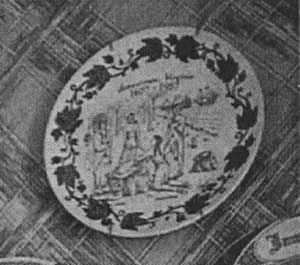
A. Pocahontas and John Smith, Jamestown, Virginia, 1607-1957
Royal China under glaze, '56
This image of the Indian maiden, Pocahontas, rescuing colonist John Smith in 1607 is one of the most highly related stories in American history. Whether a legend or a true biographical incident, this story immortalized the memory of Pocahontas and Captain John Smith.
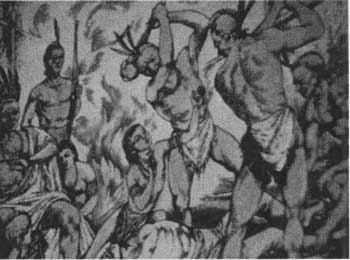
B. Princess Pocahontas Begs Life of Captain John Smith, Jamestown, Virginia
(T) Williamsburg Commemorative Ware
(Y) Williamsburg Restoration, Inc.
Wedgwood of Etruria and Barlaston, Made in England Princess Pocahontas begs life of Captain John Smith who had been allegedly sentenced to death by King Powhatan. The border shows: the ships which brought the colonists to Jamestown in 1607; the old church tower at Jamestown; the Moorehouse at Yorktown where articles of capitulation were crafted; Washington firing the first cannon at the siege of Yorktown; the Capital and Governor's Palace at Williamsburg.

C. Jamestown, 1607-1957
David J. Gregory, Jr.
Bernard J. Davis
Manufactured by Conrad Crafters, Inc., Wheeling, West Virginia
Reg. No. GU25978 Dec. 2, 1955.
On the border of this plate are shown the portraits of colonist Captain John Smith, and Pocahontas, daughter of the great Chief Powhatan. The plate illustrates Pocahontas pleading for Smith's life when Powhatan allegedly wanted him put to death. This story, widely popular in America and England, remains controversial.

D. Man in Wintertime
Wedgwood Eturia and Barlaston, Made in England, Queensware.
A Commemorative Edition on the occasion of the 400th anniversary of the Roanoke Voyages to North Carolina and in celebration of our American Indian heritage, Ivey's Carolinas commissioned Wedgwood to create this North Carolina coastal Indian motif plate.
This Queensware fine earthenware plate is composed in part of western North Carolina Cherokee clay first used by "The Father of English Potters," Josiah Wedgwood in 1768. Iveys.
Illustration is from a Theodor de Bry engraving, based on watercolors by John White. Theodor de Bry (1528-1598) was a Flemish emigrant in Germany, who produced America, a series about the New World.
The de Bry prints of John White's illustrations are widely accepted today by Virginia Indians. White's watercolors portray a lifestyle of North Carolina Algonquian Indian women, similar to that in which Pocahontas was raised. She would have been taught how to be independent as a child.
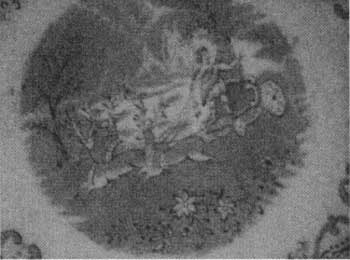
E. Pocahontas
Staffordshire, England
Pocahontas was a popular figure in the mid-nineteenth century, both here and in England and France. Believed to be ten to eleven years old, when the colonists arrived, Pocahontas was an icon of the "good Indian." She risked her life carrying food and information to the colonists and later converted to Christianity. This unique plate, with the reindeer image, is reminiscent of mythological scenes. Produced mid 19th century, only 2000 plates and a bowl are said to exist.

F. Jamestown, 1607-1907
Vienna Art Plates. Pat. February 21, 1905
Copyrighted by WH Owens and Co., Manchester, Virginia
This is one of the pieces selected for the 1907 tercentennial celebration of the settlement of Jamestown. The image was duplicated fifty years later for the 350th anniversary of Jamestown. Captain John Smith was instrumental in the establishment and survival of the British colony at Jamestown. His allegedly miraculous salvation by Pocahontas in 1607 has become legendary. In 1624, Smith recorded this adventure in his writings, greatly enhancing and embellishing it from his earlier report in 1608. This historical event has become a popular choice for artists and illustrators both here and in Europe.

G. Jamestown, 1607-1957, 350th Anniversary
Wheeling Decorating Glass China, West Virginia. PM—A
The best known exploit recounted of John Smith, adventurer and soldier, is the story of his rescue by Pocahontas. According to legend, her father, Chief Powhatan, had ordered Smith's head to be crushed between two stones, when Pocahontas intervened and pleaded for his life to be spared. The story is controversial and Pocahontas was never able to tell her own version, as she died from an illness at the young age of about 22, prior to Smith's written account being made public.

H. Jamestown, 1607-1957
No identification on this plate as to origin of manufacture.
Illustration of Captain John Smith's story of the Indian Princess Pocahontas rescuing him in 1607, from death at the hands of her father, Chief Powhatan of the Algonquian Nation. A Powhatan intertribal hunting party captured Smith, an adventurer, when he wandered too far along the banks of the Chickahominy River, west of the Jamestown settlement. Smith's captor was Opechancanough, Powhatan's half brother. He escorted the English Captain through a number of Indian villages, where he was displayed, until he was finally taken to Powhatan's capital, Werowocomoco.

H2. The Marriage of Pocahontas at Jamestown, Virginia, 1813
Nuesbaum Book and Art Co. 100-102 Granby Street, Norfolk, Virginia, F.B. & Co. 3-07
This plate is misdated. The wedding of Pocahontas, April, 1614, took place in Jamestown, or possibly Henrico. This commemorative plate was made in 1907 to commemorate the tercentennial of the settlement of Jamestown.
This is an idealized, fantasy image of Pocahontas's marriage in 1614, by artist Henry Brueckner. It was the first recorded marriage in the New World between an Indian and a colonist. Pocahontas's father, Chief Powhatan, who hoped it would bring peace between the colonists and the Indians, blessed the marriage. By the time of her marriage, Pocahontas had been converted to Christianity, and given the name Rebecca. Conversion was a requirement by the Church, before she could marry John Rolfe.
Coin

Pocahontas, 1607-1907
Gilt coin, so called Dollar. A U.S. Mint Official Medal, 1907 Struck in US. Mint for the Jamestown Ter-Centennial Exposition in 1907
One side of the coin depicts the head of Pocahontas; the other side is sailing ships. The Jamestown Exposition, celebrating the three hundredth anniversary of the birth of this Nation, was held from April 26 to November 30th, 1907, on the shores of Hampton Roads, in Virginia.
"There is no land so fair
As Old Virginia,
So full of song, so free from care,
As Old Virginia,
And I am sure that happy land
The Lord prepared for mortal man,
Is built exactly on the plan
Of Old Virginia."
Jamestown Exposition, 1907
Antique Prints

I. Pocahontas
Reproduction of an engraving by L. C. Buttre
Engraved expressly for Ladies' Repository by L. C. Buttre, New York
Published in 1861
This image depicts Pocahontas in dress (regalia) traditionally worn by adult Indian women in Pocahontas's day. It is still worn today for powwows, and on special occasions, such as Tribute Day, when Virginia's Pamunkey and Mattaponi tribes visit the State Capital in Richmond and present the Governor with gifts of wild game in a ceremonial payment of taxes.
Early 1585-1586 watercolors by John White depict Powhatan girls before the age of puberty as wearing no clothing. As young teenagers, they wore a simple deerskin apron. On occasion, they wore feathers or flowers in their hair.
When the colonists landed in 1607, Pocahontas is documented in English writings as running through the settlement naked. The conclusion is she was under 12 years of age, a child.

J. The Marriage of Pocahontas and John Rolfe
An original print from the initial 1855, oil on canvas, painting by artist and printmaker, Henry Brueckner.
This rendition is imaginary, yet astonishing in historical details and observations. It gives a fascinating portrayal of the marriage of Pocahontas to Colonist John Rolfe. The original engraving by John McRae is 24x34. Joseph Laing, who at mid century began distributing large prints in New York, London and Edinburgh, published it. This rendition is largely a fantasy, as little was known of the actual event. It is noteworthy that most of the wedding guests are English, though a number of Indians are depicted, such as Pocahontas's two brothers and her Uncle Opachisco. John Rolfe represents the best of English gentlemen and Pocahontas is portrayed as fairly exotic looking. The marriage brought peace between the colonists and the Indians, at a time when relations between the English and the Indians were hostile.

K. Captain John Smith Rescued by Pocahontas
E. Corbould, artist
T. Knight, engraver
The artist has romanticized the legendary story of John Smith's rescue by depicting the Indian Princess in this engraving, complete with a waterfall and horse. An exploration party captured Smith in 1607, west of Jamestown, along the Chickahominy River. Smith, in his writings, describes being taken to the mighty Chief Powhatan, Pocahontas's father, and sentenced to death. Pocahontas successfully pleaded with her father to save his life. The story that Powhatan wanted Smith put to death is controversial.
No Image
L. Pocahontas
Colored engraving
Artist and engraver unknown
Circa 1940
This lovely forest scene is typical of many artistic depictions of Pocahontas as a woodland "creature." Her future English husband, John Rolfe, referred to Pocahontas as a "lovely creature" in a letter he wrote. She is wearing traditional Indian dress, called "regalia" by Indians. A popular 19th century nickname for Pocahontas was "Child of the Forest." Known to the Colonists as "Pocahontas," her own people called her "Matoaka." The English named her "Rebecca." Americans later came to revere Princess Pocahontas, daughter of Chief Powhatan, as the "Mother of the Nation."

M. Pocahontas
Reproduction of an engraving, 1840
G. Staal, artist; E. Charden, engraver
Imp. E. Charden, Frenchaine, 30r. haute feuille, Paris, France, Pocahontas
Staal, as many artists during the past four centuries, depicted Pocahontas differently from the way she actually was. In this reproduction of an engraving, Chief Powhatan's daughter seems to be a member of French high society. Note how differently the Indian girl has been depicted. How might a Virginia Indian have depicted her?
Algonquian women customarily tattooed themselves. They valued jewelry highly, often wearing multiple necklaces, bracelets and earrings of pearl, copper, shell or bone. Powhatan's wedding gift to his daughter was a large single strand pearl necklace. He did not attend her wedding for fear of capture by the Colonists.
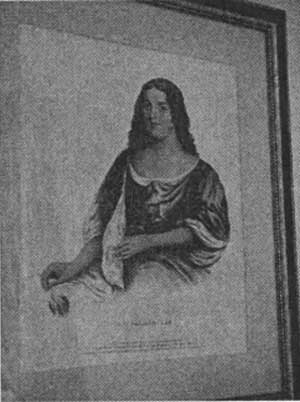
N. Pocahontas
Copy of an engraving produced by Thomas McKenney and James Hall for their three volume collection; Indian Tribes of North America; circa 1844. William Cole donated one of these original prints to the Virginia Historical Society in Richmond; Virginia. The image in the various editions varies slightly.
The large colored lithograph from which the above mentioned print was made of Pocahontas, was drawn, printed and colored by Daniel Rice and James G. Clark and produced at the Lithographic & Print Coloring Establishment in Philadelphia, in 1842.
Known as "The Turkey Island Portrait," the original painting was acquired circa 18th c. in England by the Randolph family and brought to their ancestral home on the James River, Turkey Island. In 1830, at the urging of the well-known portrait artist Thomas Sully, his nephew Robert Mathew Sully made a copy of the painting. It would be ten years or so before Daniel Rice and James Clark made their lithograph of Sully's copy.
This lithograph proved controversial. Originally, both Sully and McKenney believed the Turkey Island Portrait to have been painted from real life. However, the dress worn by Pocahontas did not exist before the second half of the 19th c. Also, many thought the image course. The legendary Indian Princess is generally perceived in our mind's eye, to have been thin, beautiful, with straight black hair and darker skin. The Turkey Island Portrait is a Europeanized depiction.

O. The Crowning of Powhatan
Colored etching
J. G. Chapman, artist,
R. Hinshelwood, engraver
Engraved for Graham's Magazine, from an original picture.
Europeans called the mighty Chief Powhatan "a king," which made his daughter, Pocahontas, a Princess. Chief of the Algonquian Nation, Powhatan ruled a chiefdom of thirty-plus tribes in what is today, Henrico County and eastern Virginia. According to Virginia Indian oral history, Powhatan is buried on the Pamunkey Reservation in King William County, Virginia.

P. Captain Smith and Pocahontas
Colored Etching
Drawn by J. Morton; Esq.
Engraver unknown
This image represents the legend of Pocahontas rescuing Captain John Smith from death at the hands of her father, Chief Powhatan. Pocahontas pleads for Smith's life as he is about to be clubbed to death. According to Indian lore, Pocahontas saved others, as well as Smith. This is also acknowledged in a letter written by Smith in which he states that more than any other person, an Indian child named Pocahontas has saved the colonists from death and starvation.
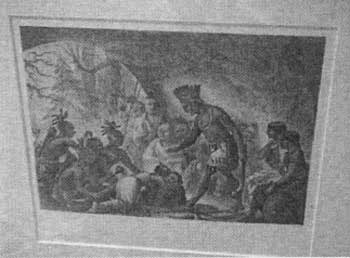
Q. Captain John Smith Rescued by Pocahontas
Drawn by A. C. Warren
Engraved by D. G. Thompson
This antique print is a rendition of the popular legend of Chief Powhatan's dearest daughter, Pocahontas, saving the life of Captain John Smith, a leader of the English Colonists. One theory among modern scholars, as well as Native oral history, is that the event was an adoption ritual. Smith and Pocahontas remained life long friends. A brotherly/sisterly affection would explain why Pocahontas was distraught over Smith's lack of communication with her, while she was in London. Others have interpreted Pocahontas's reaction as being a romantic rejection.

R. A Song of Old Jamestown
1907 Sheet Music
By N. Brant Robertson
Published by F. P. Robertson, 108 S. Howard Street, Baltimore, Maryland
The celebration of the 300th anniversary of the Jamestown Settlement in 1907 was the impetus for the creation of A Song of Old Jamestown. The sheet music prominently features an image of Pocahontas, a marketing tool of the era.
No Image
R2. Pocahontas Saving the Life of Captain John Smith
Colored Print
Engraving by Kellogg and Thayer
Circa 1830
Did Pocahontas rescue Captain John Smith? Some believe John Smith's life was never in danger, the "rescue" being seen as a test of manliness, even an adoption ceremony or ritual misunderstood by Smith. The question may never be answered definitively. The "Pocahontas Saving Captain John Smith" narrative has been told and retold, enhanced and embellished for nearly four hundred years. Today, it is one of the best known episodes in American history.
Memorabilia
No Image
S. Pamunkey Indian Reenactment of Pocahontas Saving Captain John Smith's life, Jamestown, Virginia
A stereoscopic card for a stereoscope, an optical instrument (1850-1855), Keystone Viero Company Manufacturer. No. 14196
This card depicts Pocahontas pleading for the life of Captain John Smith. Pamunkey Indian tribe at the Jamestown Exposition, 300 years after John Smith was allegedly rescued, re-enactment 1907.

Front (left), Back (right)
T. Grind Your Own Coffee
Advertising collectable card depicting many small historic scenes or vignettes referencing John Smith, the Jamestown colony. Arbuckle Bros. of New York City. This is one of a series of fifty cards giving a pictorial history of the United States and Territories: The Ruins of the Old Church First Settlers at Jamestown, 1607 Pocahontas Saving the Life of Captain John Smith, Punishment by Pillory in Colonial Days, the fight between the "Monitor and the Merrimac."
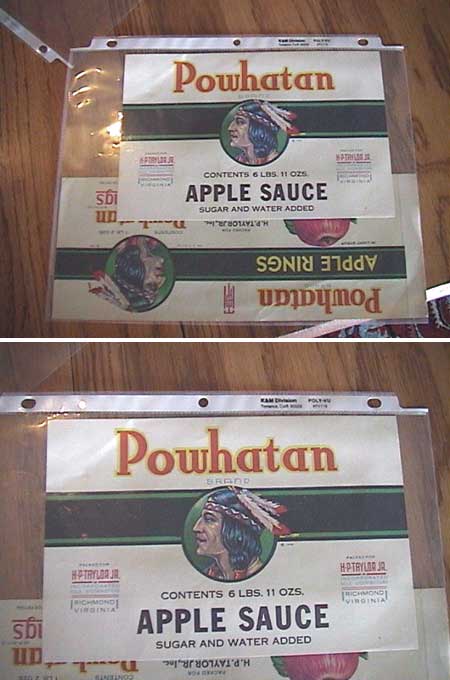
U. Powhatan brand label for applesauce and apple rings

Front (left), Back (right)
V. Playing Card
Radioslip Joker card Playing card from a deck used on the Norfolk & Western "Pocahontas Train."

Front (left), Back (right)
W. Postcard for Hotel Pocahontas
Dated July 22, Newport News, Virginia
Uses a one-cent stamp
Hotel Proprietor, Tmos. J. Hundley
Postcard scene is overlooking Newport News Shipbuilding and Dry-dock Co. and Hampton Roads, Virginia.

X. Pocahontas Creamer Packets
| <<< Previous | <<< Contents >>> | Next >>> |
jame/moretti-langholtz/appendixb.htm
Last Updated: 22-Nov-2006